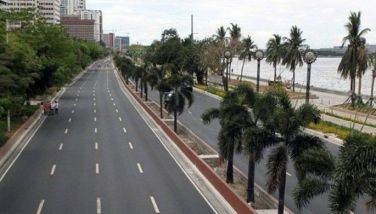Crop damage due to drought hits P3.7 billion
MANILA, Philippines - Crop damage caused by the continuing El Niño phenomenon has reached P3.77 billion as of Feb. 17, the Department of Agriculture (DA) said.
DA Undersecretary Joel Rudinas said corn damage has reached P2 billion, while palay (paddy rice) damage has reached P1.7 billion. Damage to high-value commercial crops (HVCC), on the other hand, reached P1.3 million.
Data from the DA showed that as of the first half of the month, Luzon and the Visayas have borne the brunt of El Niño.
Rudinas said, however, that some areas are still experiencing good farming conditions even as other areas are badly affected.
Corn damage affects the production of animal feeds. Most hog and poultry raisers use corn as a major component in mixing animal feed. Higher corn price raises the cost of feed.
Lower palay production this year, on the other hand, would force the government to import more rice.
Intense heat is drying up farmlands, reservoirs and waterways all over the country.
The province of Isabela, the hardest hit by drought, was recently placed under a state of calamity after suffering more than P1 billion in agricultural losses.
The Philippine Atmospheric, Geophysical and Astronomical Services Administration (Pagasa) said the onset of the rainy season will be a month late because of the ongoing drought.
The rainy season usually begins in the second half of May.
Pagasa administrator Prisco Nilo said the El Niño already reached its peak in December 2009 to early January this year. However, most climate models show the drought will continue until June.
“A gradual decrease in sea surface temperature in the central eastern equatorial Pacific is expected during the months of April-May-June, but still within the El Niño threshold. With this condition, a delayed onset of the rainy season associated with the southwest monsoon is likely and may only commence in the second half of June,” Nilo said.
Rice and corn production in La Union down
The provincial agriculture office of La Union said the El Niño phenomenon has started to affect the production of rice and corn in the province.
Provincial agriculturist Avelino Lomboy said around 1,500 hectares of land intended for rice and corn have not been used this season because of the dry spell.
He also said the drought has already destroyed hectares of rice and corn in the towns of Bangar, Balaoan and portions of southern La Union.
“We recently visited farms in the northern towns of La Union particularly near the Amburayan River. With no rainfall for the next two weeks, damage to rice and corn is unimaginable.” Lomboy said.
Farmers in irrigated areas concentrate on vegetable farming at the moment because vegetables do not need as much water as rice or corn. Around 4,700 hectares of agricultural lands in La Union are cultivated for vegetable production.
Some lands also have tobacco plants, which are now ready for harvest.
“Out of those areas planted with vegetables, 20 percent is expected to be damaged. The flow of water is slowing although those who have luckily planted earlier are about to harvest,” Lomboy said.
Fishponds are also affected by the drought.
“If water level is low, there is a lack of oxygen and water temperature becomes hotter, and that would kill the fish,” Lomboy said.
Fish breeders are also alerted for a possible occurrence of red tide.
Poultry industry among hardest hit
A joint study by the Department of Agriculture (DA), the Bureau of Animal Industry (BAI) and the Embassy of Israel showed that the poultry industry is expected to be one of the hardest hit by the drought.
Fowl may suffer from excessive heat stress during the dry season because, lacking sweat glands, they do not perspire.
Fowl convulse and die when exposed to extreme heat.
“The most obvious sign of heat stress is panting. Severe panting takes a lot of energy and ultimately results in death because of heat exhaustion,” the study said.
Temperatures above 18 to 24 degrees Celsius will also affect the growth and feeding habits of fowl, as well as their egg production. The size of the egg and the shell quality will also suffer. Moreover, the hatching rate of chicks will also be affected.
The report advises the adoption of heat management practices such as providing adequate drinking water, avoiding overcrowding of poultry houses, and keeping the ground below poultry houses manure-free.
“Manure will restrict the airflow and produce additional heat through the natural decaying process... More water is consumed by birds during hot weather in order to prevent dehydration. Cool drinking water stimulates both feed and water intake,” the study said.
Also, painting the poultry house roof with reflective paint, particularly non-insulated houses, will reduce radiation.
Hanging shade nets and curtains on the sides of the poultry house will also reduce heat. Planting shade trees like acacia, mahogany, and gmelina will also reduce radiated heat.
Sprinklers and fans may also be installed in poultry houses. Ceilings may also be lined with insulators such as urethan foam and expanded polystryrone.
Dryland farming
Former agriculture secretary William Dar is proposing the creation of a Philippine Dryland Research Institute (PhilDRI), an organization that will help mitigate the effects of El Niño in the agricultural sector.
“PhilDRI will be the country’s first line of defense against drought and climate change. Likewise, PhilDRI will substantially contribute to poverty alleviation by generating and mobilizing science and technology to improve the livelihoods of poor communities in the drylands,” Dar said in a statement.
Dar, the current head of the India-based International Crops Research Institute for the Semi-Arid Tropics (ICRISAT), also urged Filipino farmers to plant drought-resistant crops this dry season.
He said ICRISAT and its partners in the country have introduced improved varieties of sorghum, pigeonpea, chickpea and peanut that can withstand drought.
He said farmers should also grow crops that mature earlier.
“Short duration crops thrive and yield well even with scarce water as they mature before soil moisture gets depleted,” Dar said.
He said the government should also educate farmers about dryland agriculture and enable local government units to create policies supporting dryland farming.
“Rice imports this year may hit a record 2.4 million tons as the country makes up for the crop damage inflicted by typhoons Ondoy, Pepeng and Santi. The production of other crops like corn, sugar cane, vegetables and other agricultural products will also be severely affected,” Dar said.
The government is importing 200,000 metric tons of rice at zero-tariff to prevent a shortage which may lead to skyrocketing rice prices. - With Helen Flores, Jun Elias, Rudy Fernandez
- Latest
- Trending































